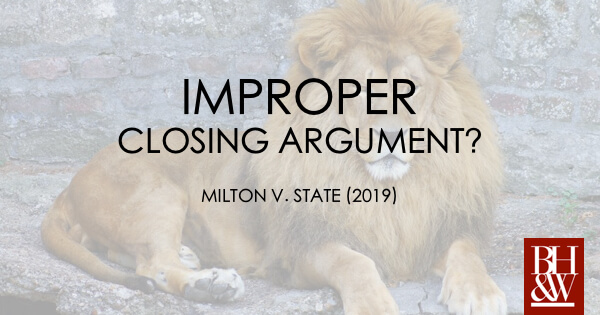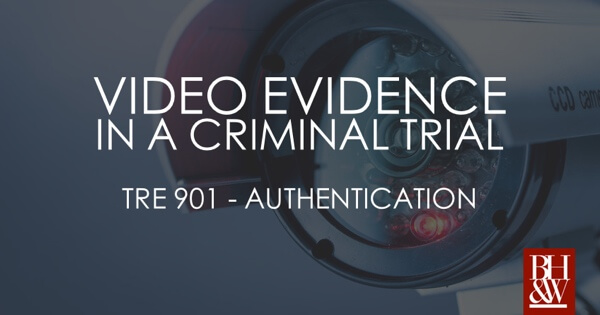
New CCA Opinion – Watkins v. State – Clearly Interprets the Duty of the State in Discovery.
 Prosecutors in Texas must disclose almost all of the evidence in their possession to the defense. Disclosure is the rule and not the exception in Texas.1 Section 39.14(a) of the Texas Code of Criminal Procedure requires the prosecution to disclose anything that “constitutes or contains evidence material to any matter involved in the action. . .”2
Prosecutors in Texas must disclose almost all of the evidence in their possession to the defense. Disclosure is the rule and not the exception in Texas.1 Section 39.14(a) of the Texas Code of Criminal Procedure requires the prosecution to disclose anything that “constitutes or contains evidence material to any matter involved in the action. . .”2
The Texas Court of Criminal Appeals in Watkins v. State (see opinion HERE) recently interpreted the word “material” to mean the equivalent of “relevant,” while interpreting the phrase, “any matter involved in the action,” as covering “any number of subsidiary issues impacting the outcome of the proceedings.”3 This interpretation requires Texas prosecutors to disclose virtually all of the evidence in their possession—more than they are mandated to under the federal Constitution as interpreted by the Supreme Court in Brady v. Maryland. In fact, for some types of evidence, the statute does not require the evidence to meet any materiality requirement.4 According to § 39.14(h), evidence tending to negate the guilt or mitigate the punishment of a defendant must be disclosed, regardless of whether the evidence is considered material or requested by the defense.5
Article 39.14 and the case law that accompanies it effectively establish an open-file policy between the prosecution and defense. As the Watkins court put it: “[w]ith the exception of privileged evidence and evidence specifically covered by other statutory provisions, the only obstacle to disclosure of evidence not [exculpatory in nature] is the lack of a specific request.”6
The “materiality” language that the Watkins court addressed is actually language that was carried over from a previous version of Article 39.14—language with its own case law that prosecutors and trial courts carried into practice even after the statute was amended.
How did Prosecutors Interpret 39.14 Before Watkins?
The current version of Article 39.14 came about through the Michael Morton Act, signed into law by Governor Perry in 2013. This bill was a response to the case of Michael Morton, a man wrongfully convicted for the murder of his wife in 1987 after the prosecutor in that case withheld evidence that could have proven his innocence. Morton was exonerated in 2011 after DNA evidence revealed that someone else committed the murder, and the state legislature took up the task of passing a complete overhaul of discovery procedure in Texas.
Because the same language— “material to any matter involved in the action”—was retained by the Morton amendments, confusion persisted among some attorneys about whether the pre-Morton “materiality” jurisprudence is properly attributed to the new, post-Morton version of Article 39.14. However, as the Watkins court addressed, those pre-Morton cases never actually spoke to the issue of what “material” actually meant.7
The Confusion Surrounding “Material”
You see, the pre-Morton Article 39.14 gave trial courts the discretion whether to order the prosecution to disclose evidence upon a motion showing good cause from the defense.8 The pre-Morton “materiality” jurisprudence was inextricably linked with the standard for determining whether a trial court abused its discretion in refusing to issue such an order, and it did not have anything to do with the phrase, “material to any matter involved in the action.”9
The standard for determining whether a trial court abused its discretion in this way was whether the judge’s ruling deprived the defendant of access to evidence that was material to the defendant’s defense.10 “Material,” in this sense, was defined “’under Texas law in the due process terms employed by the Supreme Court in United States v. Agurs.’”11 This meant that a trial judge abused his or her discretion in refusing to order the disclosure of evidence when it was exculpatory in nature.12
Watkins Clearing Things Up
As we now know, the procedure that discovery followed before the Morton amendments was completely removed from Article 39.14, and the “materiality” jurisprudence that was tied to it went out the door as well.13 Because of the confusion that accompanied the judicial use of similar language in close contexts pre-Morton, it is understandable if some prosecutors may have—before Watkins—interpreted the, “material to any matter involved in the action,” language as being loaded with the pre-Morton jurisprudence. Other prosecutors, as shown in Watkins below, applied their own limiting interpretations to the language.
In Watkins, the defense counsel sent a discovery request to the prosecutor pursuant to § 39.14 asking for, “any other tangible things not otherwise privileged that constitute or contain evidence material to any matter involved in the case.”14 He “also requested notice of the State’s intent to offer any extraneous offenses, which the prosecution provided.”15 Watkins was convicted of second-degree possession of a controlled substance, and during the punishment phase of trial, the state sought to introduce 34 exhibits for the purpose of proving up Watkins’ prior felony convictions for enhancement purposes.16 The defense objected—the prosecutor did not disclose the exhibits to the defense because he did not believe Article 39.14 applied to punishment.17 The Trial court overruled the objection, allowing the evidence to be admitted.18
The issue surrounding the prosecution’s non-disclosure eventually worked its way up to the Court of Criminal Appeals, where the Watkins court seized the opportunity to review the requirements of Article 39.14 in light of the Michael Morton Act amendments. In short, the Court laid out the history of Article 39.14 explained above, and it clearly established that Texas now has disclosure requirements that track the spirit of the Michael Morton Act.19
[1] Watkins v. State, NO. PD-1015-18 (Tex. Crim. App. 2021).[2] Tex. Code Crim. Proc. Ann. art. 39.14(a) (West 2017).
[3] Watkins, at 24-25.
[4] Tex. Code Crim. Proc. Ann. art. 39.14(h) (West 2017).
[5] Id.
[6] Watkins, at 23.
[7] Id. at 35.
[8] TEX. Code Crim. Proc. art. 39.14 (2009).
[9] Watkins at 35.
[10] Id. at 41-42.
[11] Id. at 40 (quoting United States v. Agurs, 427 U.S. 97 (1976)).
[12] Id. at 41.
[13] See generally Watkins.
[14] Watkins at 4.
[15] Id.
[16] Id.
[17] Id.
[18] Id. at 5.
[19] See generally Watkins.


 What do Atticus Finch, Lt. Daniel Kaffee, and Jake Brigance have in common? Each of these fictional movie attorneys are known for zealously representing their clients by delivering intense cross examinations and galvanizing closing arguments. Finch, defending a wrongly-accused man in a time a place where justice was compromised by racial bias, implored the jury to seek justice by tapping into a higher power, “In the name of God do your duty.” Stuck at the crossroads of respecting formal rank and seeking justice in a military court-martial, Lt. Kaffee made the choice to double down on Col. Jessep during cross examination, poking at the Colonel’s pride. Col. Jessep took Lt. Kaffee’s bait, screaming, “You can’t handle the truth!” Jake Brigance took a more creative approach. Asking jurors to close their eyes, Brigance described a depraved series of events that caused his client to murder two people. The jury agreed with the justification, and acquitted Brigance’s client.
What do Atticus Finch, Lt. Daniel Kaffee, and Jake Brigance have in common? Each of these fictional movie attorneys are known for zealously representing their clients by delivering intense cross examinations and galvanizing closing arguments. Finch, defending a wrongly-accused man in a time a place where justice was compromised by racial bias, implored the jury to seek justice by tapping into a higher power, “In the name of God do your duty.” Stuck at the crossroads of respecting formal rank and seeking justice in a military court-martial, Lt. Kaffee made the choice to double down on Col. Jessep during cross examination, poking at the Colonel’s pride. Col. Jessep took Lt. Kaffee’s bait, screaming, “You can’t handle the truth!” Jake Brigance took a more creative approach. Asking jurors to close their eyes, Brigance described a depraved series of events that caused his client to murder two people. The jury agreed with the justification, and acquitted Brigance’s client.
 During routine traffic stops, police officers sometimes end up arresting individuals for the third-degree felony offense of Tampering with Evidence. How does this happen you ask? If, during the course of a traffic stop, an officer observes the driver toss an item or two out of the window, and those tossed items are later determined to be drugs and/or drug paraphernalia, the officer might just arrest the person for tampering with evidence pursuant to
During routine traffic stops, police officers sometimes end up arresting individuals for the third-degree felony offense of Tampering with Evidence. How does this happen you ask? If, during the course of a traffic stop, an officer observes the driver toss an item or two out of the window, and those tossed items are later determined to be drugs and/or drug paraphernalia, the officer might just arrest the person for tampering with evidence pursuant to 
 Did you ever get the feeling like someone is recording your conversation?
Did you ever get the feeling like someone is recording your conversation? 
 Technology has dramatically changed the landscape of criminal law procedure, and ultimately criminal convictions, in Texas.
Technology has dramatically changed the landscape of criminal law procedure, and ultimately criminal convictions, in Texas. 
 DWI Update: Some clients want to see their DWI video. Some don’t. Some want to take it home and show their friends and some want to dig a deep hole and bury it away forever. Since the passing of the Michael Morton act, regardless of their clients’ wishes, criminal defense lawyers could not provide a copy of the DWI video without first obtaining a court order or prosecutor permission. This all changes on 9/1/15.
DWI Update: Some clients want to see their DWI video. Some don’t. Some want to take it home and show their friends and some want to dig a deep hole and bury it away forever. Since the passing of the Michael Morton act, regardless of their clients’ wishes, criminal defense lawyers could not provide a copy of the DWI video without first obtaining a court order or prosecutor permission. This all changes on 9/1/15.
 Posted by Luke A. Williams.
Posted by Luke A. Williams.
 Under Texas Penal Code § 20.04(d), a kidnapper who voluntarily frees his victim in a safe place reduces his or her punishment level for aggravated kidnapping from a first-degree to a second-degree felony. In construing a “safe place,” Texas courts consider seven factors:
Under Texas Penal Code § 20.04(d), a kidnapper who voluntarily frees his victim in a safe place reduces his or her punishment level for aggravated kidnapping from a first-degree to a second-degree felony. In construing a “safe place,” Texas courts consider seven factors:
 Laying the foundation for the admission of evidence can be tricky. Often quite technical. Even hypertechnical. Depending on what you are trying to admit, you might need affidavits, chain of custody records, etc. With the advancement of the internet, something trial lawyers of old did not even think about, there is more evidence out there. Good evidence. Sometimes really good evidence. Social media sites can provide a wealth of evidence for criminal trial lawyers on both sides of the aisle.
Laying the foundation for the admission of evidence can be tricky. Often quite technical. Even hypertechnical. Depending on what you are trying to admit, you might need affidavits, chain of custody records, etc. With the advancement of the internet, something trial lawyers of old did not even think about, there is more evidence out there. Good evidence. Sometimes really good evidence. Social media sites can provide a wealth of evidence for criminal trial lawyers on both sides of the aisle.





